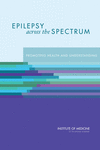US Institute of Medicine Report
Epilepsy Across the Spectrum, Promoting Health and Understanding

Epilepsy Across the Spectrum - IOM Report Brief, March 2012
Epilepsy Across the Spectrum - Complete Report
The Institute of Medicine report addresses the many obstacles faced by people with epilepsy and their caregivers in obtaining the necessary care. Although the report was written to address the situation in the United States, a quick review of the findings show that the recommendations can be applied in most countries. The issues are familiar to everyone in the epilepsy community: lack of access to appropriate care, failure to address the broad psychosocial consequences of the disease, poor knowledge and understanding of epilepsy by the public and broader medical community and the stigma of having epilepsy which keeps the disease hidden even though it is one of the most common neurological disorders. All of these problems are laid out in great detail in this report.
One may wonder why this report, if these are its findings, is so important. Everyone involved with epilepsy care has faced these issues on a regular basis so the problems are common knowledge. Those concerns are appropriate, but one has to realize that this report is the first time that these issues have been addressed objectively by a group of experts that include many from outside the field. The group concluded that epilepsy and its many accompanying problems require far more attention than they have received by the medical community, society and the health authorities.
The timing for the release of the report is excellent, as it has been released shortly after the official signings of the European Declaration on Epilepsy and the Pan American Health Organization’s Strategy on Epilepsy. There have also been major national accomplishments such as the law in Colombia guaranteeing the rights of people with epilepsy as well as access to necessary health care as well as the recent agreement in the Philippines to make epilepsy a health care priority. These agreements open the door to making progress in epilepsy care, but none have a defined plan of how to move forward. This report provides a thorough and objective overview of the problems. For this reason it can serve as a starting point for planning at the national and regional level. Do not look at the report to provide solutions to the problems faced in your country. Rather use it to identify the issues that will require solutions that are specific to each country. Please read and use this report while taking advantage of the new agreements to improve epilepsy care. As we go forward we will have many opportunities to learn from one another about how we are improving the lives of people and families with epilepsy.
Subscribe to the ILAE Newsletter
To subscribe, please click on the button below.
Please send me information about ILAE activities and other
information of interest to the epilepsy community